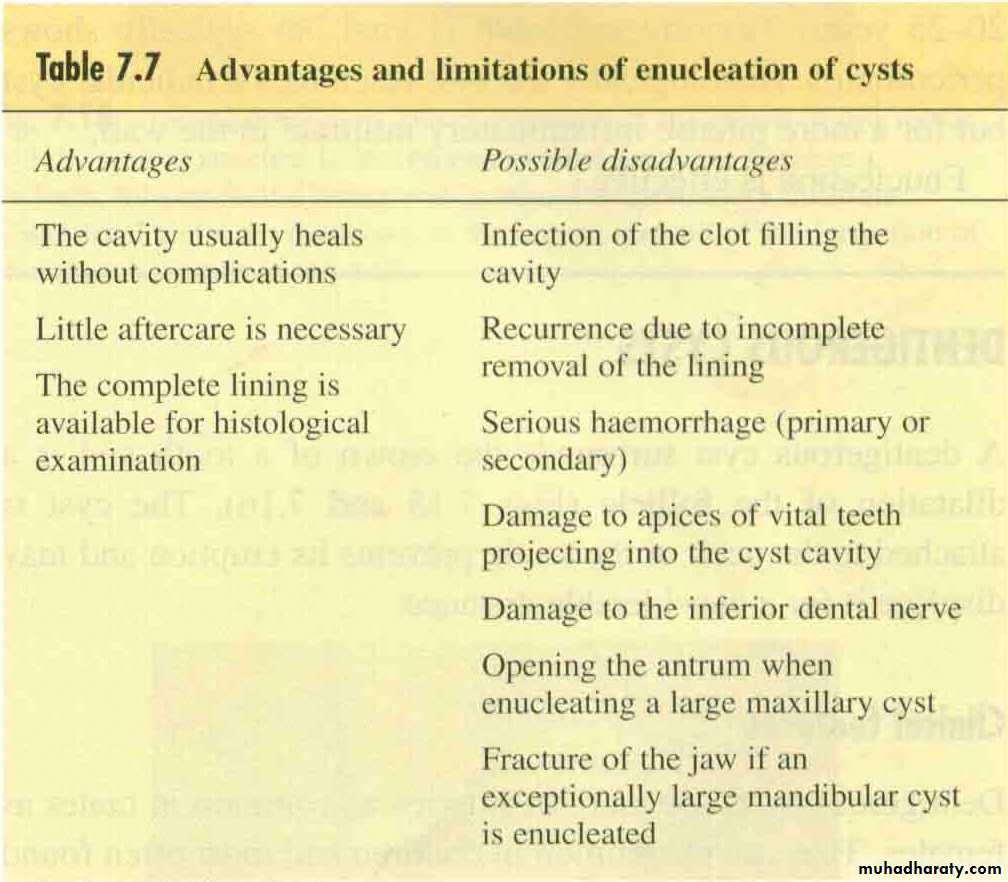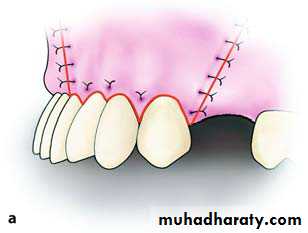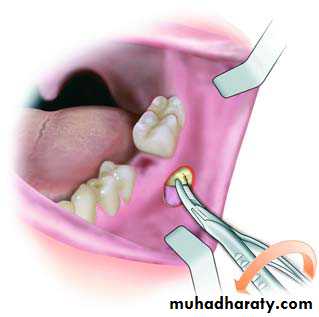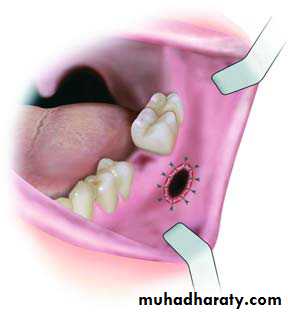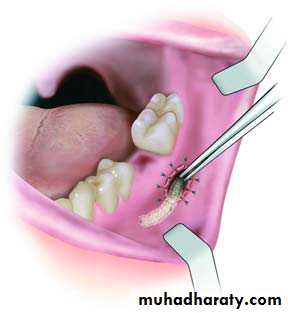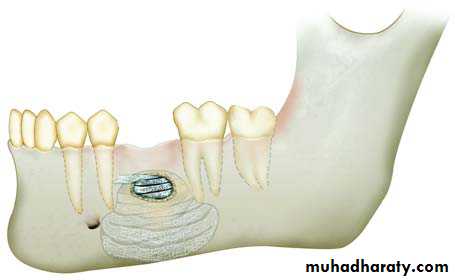TREATMENT OF THE CYST
Principles of treatmentHistory
Clinical examination.
Radiographic examination.
Aspiration of cystic fluid.
Treatment
HistoryThe patient often gives no history as many cysts may escape attention until they become infected.
Larger cysts may cause swelling of the jaw or face which in the edentulous may be associated with difficulty in wearing dentures.
In the mandible, pressure on the inferior dental nerve almost never gives rise to mental
anesthesia or paraesthesia.
History
occasionally cysts reach such proportions that excessive resorption of bone leads to pathological fracture.Eventually the majority of cysts become infected and presented with acute signs and symptoms of odontogenic infection.
Soft tissue swelling with expansion of the cortical plate (tennis ball texture, egg-shell crackling).
History
Where the cyst has invaded the soft tissues the swelling is found to be fluctuant.
At this stage, if the mucous membrane covering is thin, it will have a bluish colour.
Infected cysts have all the classical signs of acute infection and may present with a sinus discharging pus.
Clinical examination
Missing teeth must be charted and the standing teeth carefully examined for caries, periodontal disease and mobility.A dentigerous cyst may be suspected where a tooth is missing from the arch without any history of previous extraction.
The vitality of all teeth near the lesion must be tested with an electric pulp tester and the results compared with similar teeth on the unaffected side, the vitality of the adjacent teeth must be tested because cyst expansion can devitalize them.
Radiographic interpretation
Intraoral apical films usually suffice for small cysts.Larger ones may need extraoral and occlusal views of the jaws to show their full extent.
this is demonstrated by radiographs taken in two planes, as treatment planning depends on a clear understanding of their size and their relationship to those vital structures on which they may encroach.
Radiographic interpretation
Cysts appear as rounded, radiolucent areasSharply demarcated from normal bone by a thin, radiopaque limiting line of compact bone, this line is not usually present on radiographs of apical granuloma and is often absent or hazy round in infected cysts
If all the teeth are standing and vital, a cyst is unlikely to be present.
Radiographic interpretation
In the maxilla it is sometimes difficult to tell whether a radiolucent area is a cyst or a locule of the maxillary sinus. Therefore it is necessary to compare the radiographs with those of the opposite side, if a similar locule is present the radiolucent area is probably part of the sinus.Finally where doubts still exist, the area may be aspirated and if air, not fluid, is withdrawn it is certainly part of the maxillary sinus.
Aspiration
t is an important diagnostic measure which can save the surgeon from accidentally opening asolid tumour,or worse acentral haemangioma.
An aspirating syringe with a broad bore needle is used, as the contents can be quite thick.
uninfected cysts should not be aspirated more than 24 hours before operation to avoid introducing infection.
Aspiration
In those covered by thick bone it may be better delayed till, at operation, a flap has been laid back and bone removed.Microscopic examination of the aspirate may show the presence of cholesterol, soluble protein by means of electrophoresis method, which for most dental cysts will have quantities similar to that in the patient's serum.
Differential diagnosis
These lesions may all mimic odontogenic cysts in their radiographic appearanceAnatomical structures (antrum, incisive canal).
Solitary bone cyst.
Aneurysmal bone cyst.
Central giant cell granuloma.
Ameloblastoma.
Myeloma.
Where doubt exists blood chemistry, aspiration and biopsy should be performed
Assessment
This includes an estimation of their size and, particularly in the mandible, the extent of bone resorption.
Should there be a risk of a pathological fracture, the means to reduce and internally fix the mandible should be available.
The relationship of the cyst to adjacent structures is more important.
Vital teeth which have a satisfactory periodontal condition and are functional should be preserved. this is by means of apicoectomy, root canal filling.
Teeth should be extracted if they are non functional, poor periodontal condition, mobile and the patient already wear denture.
Treatment
Acutely infected cyst should be firstly treated by incision and drainage, antibiotics.further surgery is delayed till the acute phase has settled.
There are 2 methods for treating cyst:
This technique involves complete removal of the cystic sac and healing of the wound by primary intention.
This is the most satisfactory method of treatment of a cyst and is indicated in all cases where cysts are involved, whose wall may be removed without damaging adjacent teeth and other anatomic structures.
The surgical procedure for treatment of a cyst with
enucleation includes the following steps:Reflection of a mucoperiosteal flap.
Removal of bone and exposure of part of the cyst.
Enucleation of the cystic sac.
Care of the wound and suturing.
Enucleation
After reflection of the mucoperiosteum, the bone covering the lesion is evaluated, which, as mentioned , may be normal, thinned, or completely destroyed.
In normal bone, a round bur is used to remove a
portion of the buccal cortical plate covering the cyst , and depending on its extent, a rongeur may be used to enlarge the osseous window created.
Enucleation
Removal of maxillary cyst, with labial accessIncision for creating a trapezoidal flap
Enucleation
A curette is used for enucleation of small cysts, while for larger cysts, the broad end of a periosteal elevator is preferred, which is placed inside the cavity pressing gently between the cystic wall and bone, while the cyst is carefully grasped with forceps.Enucleation
Where the lining is firmly attached, 1.5cm ribbon gauze soaked in saline or in diluted hydrogen peroxide may be packed carefully into the cavity to separate the two tissue.T he lining is sent for histological examination.
careful inspection of the bony cavity for any remnant of cystic lining , the remnant frequently far back behind the root of the tooth removed by scraping the bony walls, none must be left if a recurrence is to be avoided.After removal of the cysts, a curette is used to inspect the cavity for the presence of remnants of the cyst, and copious irrigation with saline solution and suturing of the flap follow.
Enucleation
Any teeth involve in enucleation are either extracted or treated by mean of apicoectomy.Enucleation
Reflection of flap and exposure of surgical fieldRemoval of bone at the labial aspect respective to the lesion
Enucleation
Removal of cyst from bony cavity, using hemostat and curette.Surgical field after removal of lesion.
Operation site after placement of sutures
Wound break down
If the wound should break down the cavity will become contaminated with saliva and food debris, In this event the cavity should be gently packed with in ribbon gauze soaked in Whitehead's varnish and iodoform preparation to maintain an antiseptic occlusion of the space for up to 3 weeks in case of enucleation of large radicular cyst).Marsupialization
DecompressionIs the conversion of the cystic lining in to a pouch, the lining of which is continuous with the mucosa of the oral cavity.
The pressure with in the cyst is eliminated and the cystic cavity is gradually obliterated by the regeneration of bone.
De roofing
Marsupialization minimizes the danger of damage to adjacent structures such as (antrum, nose, inferior dental nerve and vessels, adjacent teeth , tooth germ, and their blood and nerve supply.It is less sever procedure and it is possible to be done by occasional oral surgeon to treat a very extensive cyst under local anaesthetic.
Marsupialization
AdvantagesPost operative pain and swelling are minimal.
It is indicated when the age and general condition of the patient limit the amount of surgery to be undertaken.
Indicated for treatment infected cyst in which removal of the lining can not be assured due to friability of tissue , When large size cystic lesion or infection of a cyst render primary closure inadvisable.
It is also employed to preserve the vitality of pulps of adjacent teeth, the apices of which are in close relation with the cystic lining .
It lessen the danger of damaging the vital structures, preserve the alveolar ridge.
It is the treatment of choice when the tooth in cystic lesion to be preserved .
Disadvantages
It has 2 major disadvantages1- the lining not completely removed.
2- bone healing is slow.Technique of marsupialization
initially a circular incision is made, which includes the mucoperiosteum, the underlying perforated (usually) bone, and the respective wall of the cystic sac.After this procedure, the contents of the cyst
are evacuated, and interrupted sutures are place around the periphery of the cyst, suturing the mucoperiosteum and the cystic wall together.
The mucoperiosteal flap and excess of the cyst lining are then removed and the lining sent for histopathological examination.
Afterwards, the cystic cavity is irrigated with saline solution and packed with iodoform gauze which is removed a week later together with the sutures.
Marsupialusation
After pack and suture removal, a cyst plug or an extension of existing denture are made in order to keep the ostium patent.During that period, the wound margins will have healed, establishing permanent communication.
Irrigation of the cystic cavity is performed several times daily, keeping it clean of food debris and prevent potential infection.
Healing of the wound is by secondary intention, and the epithelium of the cyst is thus transformed into oral mucosa.
Treatment of mandibular cyst with marsupialization method. Circular incision includes mucosa and periosteum
Packing of cystic cavity with iodoform gauze
Clinical notesRegardless the method of treatment , the pulpal status of all the teeth related to the lesion should be determined both before surgery and immediately postoperatively.
Splint should be constructed preoperatively if the size of the lesion makes fracture of the mandible a possibility.
Each form of treatment is a matter of personal opinion and preference but most authorities would advocate the enucleation of all cyst whenever possible with out incurring the risk of damage to important structures.
Bone regeneration following enucleation is more rapid than after marsupialization with minimum post operative inconvenience to both the dentist and the patient .

